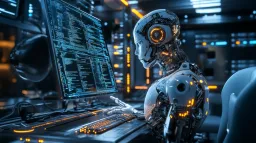AI Art vs AI-Generated Art. Whats the difference?

Artificial Intelligence (AI) has brought about many new opportunities for the creative arts. One of the most significant areas of AI’s impact on art has been the generation of art itself. However, there are two distinct approaches to producing art using AI: AI art created by generator tools and AI-generated art. While these two approaches may seem similar at first glance, they are quite different.
AI art
AI arts are the ones that can be in our control since we can give specifics on the outcome of the image. In general, AI arts are the ones that are directly created using generator tools that produce artwork using pre-existing AI tools or software. These tools are programmed with specific algorithms or parameters that allow them to generate unique and creative designs based on a set of rules or patterns. A human artist or designer creates the final product, using the AI tool as a creative tool.
Some of the most popular generator tools for AI art use deep dream algorithms, style transfer tools, and generative adversarial networks (GANs).
Deep dream algorithms use a neural network to generate images by gradually enhancing and refining a starting image. Style transfer tools, on the other hand, use neural networks to apply the style of one image to another.
When creating art using generator tools, the artist usually sets the initial parameters for the tool to follow. For eg. the style or subject matter of the artwork. The AI tool then generates new images based on these parameters. But later it is up to the human artist to select and refine the final artwork.
Pros & Cons of AI art generator
- AI art allows artists to create unique pieces without necessarily having to possess advanced technical skills. This makes it more accessible to aspiring creators who may not have had previous experience with traditional mediums.
- A major concern is whether or not the machine learning algorithms used in creating these artworks could potentially perpetuate biases present in their training data.
AI-generated art
On the other hand, the AI system itself creates AI-generated art entirely. There is little or no input from human artists. In this approach, the AI system is trained on a large dataset of images or other art forms. It uses machine learning algorithms to generate new and unique art based on what it has learned.
AI-generated art is created using various techniques such as neural style transfer, deep learning, and generative adversarial networks. These techniques allow the AI system to analyze and synthesize data. These are used to create new art that has never been seen before.
Unlike AI art created by generator tools, there is no human intervention beyond setting initial parameters or goals. The AI system generates the final artwork entirely on its own, without any influence from humans. The result is often a surprising and unique piece of art that can be quite different from what a human artist might create.
Pros & Cons of AI-generated art
- its ability to produce large volumes of artwork quickly and efficiently. This can be particularly useful for commercial purposes such as advertising or film production where speed is essential. Additionally, AI-generated art can offer unique and unexpected results that would not have been possible through traditional methods.
- While an algorithm may be able to identify patterns and shapes based on input data, it cannot replicate emotions or intentions behind them.
Difference Between AI Art and AI-Generated Art
Unlike traditional image generators, AI image generators do not require the artist to create the underlying code for the image. Instead, the artist must practice patience and precision to “train” the AI with inputs that reflect his or her artistic vision. They must also experiment with prompting the image generators, tweaking and refining the text used to describe what they want on a regular basis.
AI-generated art is often more unpredictable and unique than AI art created by generator tools. Because the AI system is generating the final artwork entirely on its own, there is a greater chance that the final product will be unlike anything that a human artist would have created.
Conclusion
Both approaches to creating AI art have their own advantages and disadvantages. In the end, the development of AI art is an exciting and rapidly evolving field that has the potential to transform the way we create and appreciate art. The incorporation of AI into the creative process, whether through AI art created by generator tools or AI-generated art, is sure to yield new and innovative forms of art that were once unimaginable.
Follow us on Instagram, Facebook, and Twitter!
Check out the news on AI-generated videos.









